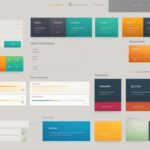Table of Contents
UI/UX design is a critical aspect of creating a positive user experience. However, it comes with its fair share of challenges that designers must overcome. From understanding user needs to creating intuitive interfaces, designers face various obstacles in their quest for exceptional design solutions. In this article, we will explore effective strategies for tackling these UI/UX design challenges and delivering an enhanced user experience.
Know Your Users
The first step in overcoming any UI/UX design challenge is to know your users. Conducting user research through methods like interviews, surveys, and personas can help gather user insights into their goals, pain points, motivations, and expectations. These insights are invaluable in guiding your design decisions and ensuring that your design aligns with user needs and preferences.
By getting to know your users on a deeper level, you can create a user experience that resonates with them and meets their expectations. Through user research, you gain a better understanding of their context, behaviors, and preferences, enabling you to design interfaces that are intuitive, user-friendly, and compelling.
“The more you know about your users, the better you can design for them.”
By uncovering user insights, you can make informed design decisions that prioritize their needs. These insights may reveal pain points and areas where your design can be improved, helping you create a seamless and enjoyable user experience.
User research also allows you to gather feedback on your design ideas and prototypes, helping you refine and iterate your designs based on real user input. This iterative process allows you to validate your design decisions and make adjustments that truly enhance the user experience.
Ultimately, knowing your users is essential in creating designs that not only meet their needs but also exceed their expectations. Incorporating user research into your design process ensures that your designs are user-centric, intuitive, and relevant.
Benefits of User Research:
- Gathers insights into user goals, pain points, motivations, and expectations
- Guides design decisions to align with user needs and preferences
- Helps create intuitive and user-friendly interfaces
- Allows for iterative design improvements based on real user feedback
- Enables the creation of compelling user experiences that exceed user expectations
| User Research Methods | Description |
|---|---|
| Interviews | One-on-one conversations with users to gather detailed insights |
| Surveys | Questionnaires designed to collect quantitative data from a large number of users |
| Personas | Creating fictional characters to represent different user types |
User Research Tips:
- Define your research goals and objectives
- Select the appropriate research methods for your project
- Recruit a diverse group of participants to gather a range of perspectives
- Conduct interviews or surveys in a neutral and comfortable environment
- Capture and document user insights accurately for future reference
- Regularly analyze and synthesize the data collected
Follow Design Principles
When it comes to overcoming UI/UX design challenges, following design principles is vital. These principles, such as simplicity, consistency, and hierarchy, play a significant role in creating intuitive and user-friendly interfaces. By adhering to these principles, designers can enhance the overall user experience.
The Power of Simplicity
Designing with simplicity in mind is key. By eliminating unnecessary elements, users can easily navigate through the interface and accomplish their goals without confusion. Strive to create clean and visually pleasing designs that focus on the essential features and functions.
Consistency for Seamless Interaction
Consistency is another critical principle to follow. By ensuring a consistent design across all screens and interactions, users will feel familiar and comfortable navigating through your product or website. Consistent color schemes, typography, and layout contribute to a seamless and intuitive user experience.
Hierarchy: Guiding Users Effectively
Establishing a clear hierarchy helps users understand the importance and relationship between different elements on the screen. By emphasizing important elements and organizing content logically, designers can guide users’ attention and make interactions more intuitive. Hierarchy improves the overall user experience and ensures that users can easily find what they need.
“Good design is obvious. Great design is transparent.” – Joe Sparano
By following these design principles of simplicity, consistency, and hierarchy, designers can create interfaces that are not only aesthetically pleasing but also highly functional and user-friendly. The right balance of design elements and thoughtful consideration of user needs will lead to better user experiences.
| Design Principle | Description |
|---|---|
| Simplicity | Avoid unnecessary elements and focus on essential features and functions. |
| Consistency | Maintain a consistent design across all screens and interactions. |
| Hierarchy | Establish a clear structure to guide users and emphasize important elements. |
Implementing these design principles is crucial for creating an intuitive and user-friendly interface. By prioritizing simplicity, consistency, and hierarchy, designers can overcome UI/UX design challenges and enhance the overall user experience.
Prototype and Test
Building prototypes and conducting usability testing are indispensable for overcoming UI/UX design challenges. These steps allow you to validate design solutions, gather valuable feedback, and identify any issues or areas for improvement. To facilitate the process, utilize a range of tools and techniques such as sketches, wireframes, and interactive prototypes. By iterating and optimizing your design based on user feedback, you can ensure a more seamless and user-friendly experience.
Prototyping and testing are instrumental in achieving optimal usability. The ability to visualize and interact with a design before implementation helps uncover potential obstacles and enhances the overall usability of the interface. By incorporating user feedback obtained through testing, designers can fine-tune their prototypes and ensure a more intuitive and enjoyable user experience.
Take a look at the example below to understand the importance of prototyping and testing:
“Prototyping is an essential step in the design process. It enables us to simulate and evaluate the user experience before investing substantial resources in development. By conducting comprehensive usability testing, we can identify pain points, improve functionality, and ensure our designs meet user expectations.”
To further illustrate the process, consider the following table showcasing the benefits of prototyping and testing:
| Benefits of Prototyping and Testing | Examples |
|---|---|
| Validation of design decisions | Evaluating different layout options to determine the most effective one |
| Gathering user feedback | Conducting usability tests to identify areas for improvement |
| Identifying and resolving design issues | Discovering confusing navigation elements and simplifying them |
| Minimizing development costs | Saving time and resources by identifying issues early in the design phase |
In conclusion, prototyping and testing play a pivotal role in successfully surmounting UI/UX design challenges. Through thorough evaluation and iteration, designers can deliver designs that not only meet user needs and preferences but also provide a seamless and delightful user experience.
Collaborate and Communicate
In order to overcome UI/UX design challenges, collaboration and communication are essential. UI/UX design is a team effort, and it requires the involvement of different roles and perspectives. It is important to collaborate with developers, product managers, and other stakeholders to ensure that everyone is aligned with the design process and contributes effectively. By working together, you can leverage the diverse expertise of the team and create a design that meets the needs and expectations of users.
Benefits of Collaboration and Communication
Collaboration and communication bring numerous benefits to the UI/UX design process. They:
- Promote a shared understanding of project goals and user requirements.
- Facilitate the exchange of ideas and insights among team members.
- Encourage problem-solving through brainstorming and constructive feedback.
- Ensure that design decisions are well-informed and based on consensus.
- Enhance the overall efficiency and effectiveness of the design process.
By actively collaborating and communicating with your team, you can harness the collective intelligence and creativity to deliver better UI/UX designs.
Using Tools for Efficient Collaboration
Utilizing the right tools can significantly improve collaboration and communication within a UI/UX design team. Here are some tools that can streamline the process:
- Design Systems: Implementing a design system enables designers and developers to work in sync, ensuring consistency and scalability across different products.
- Project Management Platforms: Tools like Trello, Jira, or Asana help in organizing tasks, setting priorities, and tracking progress, keeping everyone on the same page.
- Communication Platforms: Platforms such as Slack, Microsoft Teams, or Google Meet facilitate real-time communication, making it easy to share updates, ask questions, and collaborate seamlessly.
- Documentation Tools: Creating and maintaining documentation helps capture design decisions, guidelines, and user feedback, allowing for easy reference and knowledge sharing.
By leveraging these tools, you can foster effective collaboration, streamline communication, and enhance team productivity throughout the UI/UX design process.
Effective collaboration breeds innovative ideas and design solutions. By combining different perspectives and expertise, teams can go beyond individual limitations and create outstanding user experiences.
Learn and Improve
Continuous learning and improvement are vital in overcoming UI/UX design challenges. The field of UX/UI design is dynamic and constantly evolving. To stay ahead, it is essential to keep up with the latest trends, technologies, and best practices.
One of the most effective ways to learn and improve is by reflecting on your own experiences. Actively seek feedback from users and stakeholders to gain insights into how your designs are performing and where improvements can be made. By analyzing user feedback and incorporating it into your design process, you can identify areas for enhancement and optimize the user experience.
Industry resources such as books, blogs, and online courses are valuable tools for continuous learning. Engaging with these resources can help you stay informed about new design methodologies, tools, and techniques. By constantly expanding your knowledge base, you can broaden your design skills and apply best practices to your work.
Enhancing your design skills goes hand in hand with continuous learning. Practice and experimentation are key components of skill development. Dedicate time to hone your craft, whether it’s through side projects or participation in design challenges. By actively applying what you’ve learned, you’ll gain practical experience and refine your design capabilities.
Embrace a Growth Mindset
Adopting a growth mindset is essential for learning and improvement. Embrace challenges and view them as opportunities for growth. Be open to feedback, both constructive and critical, and use it as a catalyst for improvement. Cultivating a growth mindset will enable you to adapt to new design trends, embrace changes, and continuously push the boundaries of your design skills.
“The only way to do great work is to love what you do.” – Steve Jobs
Join Design Communities
Connecting with other UX/UI designers and joining design communities is another effective way to learn and improve. Participate in online forums, attend design conferences and events, and engage with fellow designers on social media platforms. By sharing experiences, exchanging ideas, and collaborating, you can gain valuable insights and expand your network.
In conclusion, continuous learning and improvement are essential for overcoming UI/UX design challenges. By staying up-to-date with the latest trends and best practices, reflecting on user feedback, and actively enhancing your design skills, you can deliver high-quality designs and remain competitive in the ever-evolving field of UX/UI design.
Seek Inspiration
When it comes to overcoming UI/UX design challenges, creative inspiration is key. By seeking inspiration from various sources, designers can find unique solutions to problems and create innovative designs. Consider exploring nature, art, culture, and even other products for inspiration that can fuel your problem-solving abilities.
One effective way to collect and organize your inspiration is by using tools like mood boards and galleries. These tools allow you to gather visuals, color palettes, typography, and other design elements that catch your eye. By visually collating your inspiration, you’ll have a rich resource to refer back to as you work on your designs.
H3: Examples of Design Inspiration
| Source | Description |
|---|---|
| Behance | A platform for designers to showcase their work and get inspired by other creatives. |
| Dribbble | A community of designers sharing their work, giving you a glimpse into the latest design trends. |
| Museum Visits | Visiting art museums exposes you to diverse visual styles and can spark new ideas. |
| User Feedback | Listening to your users’ feedback can inspire design enhancements and problem-solving solutions. |
Inspiration can come from various sources, and it’s important to draw from diverse places to spark new ideas and approaches. By seeking inspiration, you can overcome design challenges, unlock your creative potential, and deliver memorable user experiences.
Conclusion
Overcoming UI/UX design challenges is crucial for enhancing user experience. By understanding the needs and preferences of your users, following design principles, prototyping and testing your designs, collaborating and communicating effectively with your team, continuously learning and improving your skills, seeking creative inspiration, and employing effective strategies, you can overcome common challenges and deliver high-quality designs that meet user expectations.
By prioritizing user-centric design and continuously striving for improvement, you can create exceptional user experiences and establish yourself as a standout UI/UX designer. Remember to conduct thorough user research, create intuitive interfaces, and test and iterate your designs to ensure they align with user needs. Collaboration and communication with your team members and stakeholders are vital for successful design outcomes.
Enhancing your design skills and knowledge through continuous learning and staying up-to-date with the latest industry trends and best practices will help you deliver top-notch designs. Seek inspiration from various sources and apply problem-solving techniques to solve design challenges creatively. With these strategies in place, you can overcome UI/UX design challenges and ultimately provide an enhanced user experience that sets your designs apart in the field.
FAQ
What are some common challenges faced by UI/UX designers?
Some common challenges faced by UI/UX designers include understanding user needs, creating intuitive interfaces, and testing and iterating designs.
How can user research help in overcoming UI/UX design challenges?
User research, conducted through methods like interviews, surveys, and personas, helps gather insights into user goals, pain points, motivations, and expectations, guiding design decisions and ensuring alignment with user needs and preferences.
What role do design principles play in overcoming UI/UX design challenges?
Design principles, such as simplicity, consistency, and hierarchy, help create intuitive and user-friendly interfaces. They contribute to better user experiences by avoiding unnecessary elements, using clear labels and feedback, and organizing content logically.
How important is prototyping and testing in overcoming UI/UX design challenges?
Prototyping and testing are critical steps in overcoming UI/UX design challenges. They help validate design solutions, gather feedback, and identify any design issues or improvements. Different tools and techniques like sketches, wireframes, and interactive prototypes can be used to iterate and optimize designs based on user feedback.
Why is collaboration and communication important in overcoming UI/UX design challenges?
Collaboration and communication are key in UI/UX design as it involves different roles and perspectives. By collaborating with developers, product managers, and other stakeholders, everyone can align and contribute to the design process. Tools like design systems and documentation facilitate efficient collaboration and communication.
How can learning and improving help in overcoming UI/UX design challenges?
Learning and improving are crucial in UI/UX design. Staying up-to-date with the latest trends, technologies, and best practices through experiences, user feedback, and industry resources like books, blogs, and courses enhances design skills and knowledge, allowing designers to deliver high-quality designs and stay competitive.
Where can designers seek inspiration to overcome UI/UX design challenges?
Designers can seek inspiration from various sources like nature, art, culture, and other products. Tools like mood boards and galleries can help collect and organize inspiration. Drawing inspiration from diverse sources sparks new ideas, solves problems, and enriches design solutions.
How can overcoming UI/UX design challenges enhance user experience?
By prioritizing user-centric design and employing effective strategies like knowing your users, following design principles, prototyping and testing, collaborating and communicating, learning and improving, and seeking inspiration, designers can overcome common challenges and deliver high-quality designs that meet user needs and expectations, creating exceptional user experiences and standing out in the UI/UX design field.













